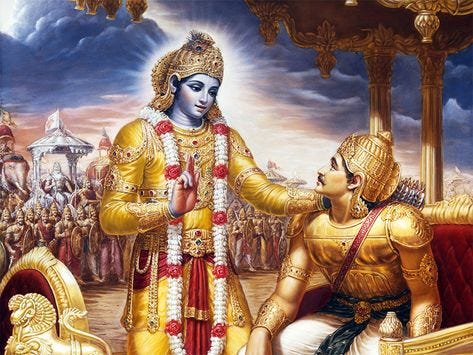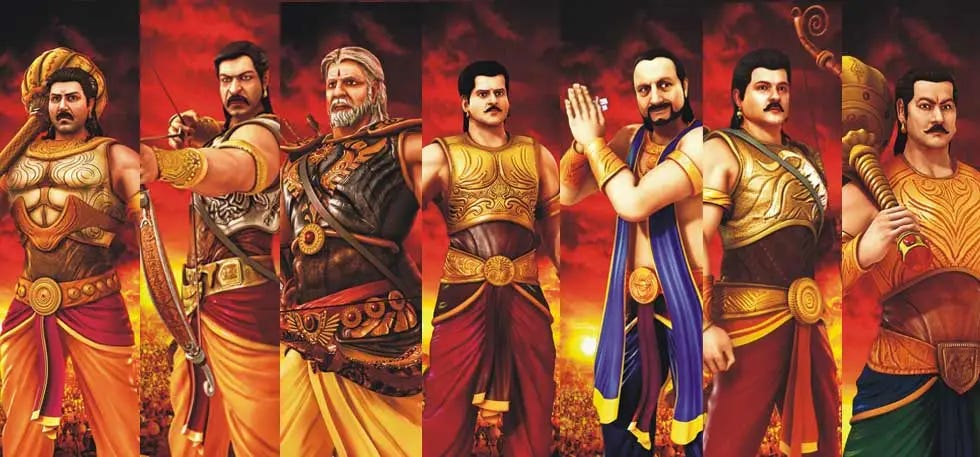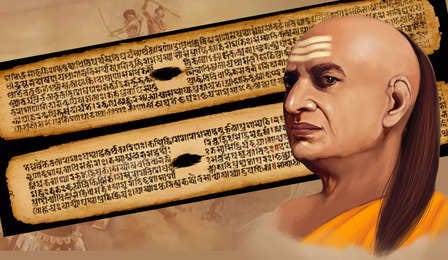Indian Knowledge System (IKS) is an innovative cell under Ministry of Education (MoE) at AICTE, New Delhi. It is established to promote interdisciplinary research on all aspects of IKS, preserve and disseminate IKS for further research and societal applications. It will actively engage for spreading the rich heritage of our country and traditional knowledge in the field of Arts and literature, Agriculture, Basic Sciences, Engineering & Technology, Architecture, Management, Economics, etc.
In this article, we will explore some of the leadership principles that can be derived from IKS, especially from the ancient scriptures such as Bhagavad Gītā (भगवद्गीता), Mahābhārata (महाभारत), Rāmāyaṇa (रामायण), Arthaśāstra (अर्थशास्त्र), and Bhoja Prabandha (भोज प्रबन्ध). These scriptures provide various perspectives on what leadership is and what it can do for an organization and society.
Leadership Lessons from Bhagavad Gītā

Bhagavad Gītā (Song of God) is one of the most revered texts in Hinduism and a part of the epic Mahābhārata. It occupies chapters 23 to 40 of Book VI of the Mahābhārata. It is a dialogue between Lord Kṛṣṇa (कृष्ण) and Arjuna (अर्जुन), the warrior prince who faces a moral dilemma before the Kurukṣetra (कुरुक्षेत्र) war. Lord Kṛṣṇa guides Arjuna on various aspects of life, such as duty, action, knowledge, devotion, ethics, and liberation.
Bhagavad Gītā offers many insights on leadership that are relevant for the modern world. Some of them are:
Nishkāma karma (निष्काम कर्म): This means performing one’s duty without attachment to the fruits of one’s actions. A leader should act with a sense of responsibility and dedication, without being swayed by personal desires or expectations. A leader should also accept the results of one’s actions with equanimity, whether they are favorable or unfavorable.
Yoga (योग): This means union or integration of one’s body, mind, and spirit. A leader should practice yoga to attain self-control, concentration, clarity, and calmness. Yoga also helps a leader to align one’s actions with one’s values and goals. A leader should also inspire others to practice yoga for their own well-being and growth.
Swadharma (स्वधर्म): This means one’s own duty or nature. A leader should recognize one’s own strengths and weaknesses, talents and limitations, preferences and aversions. A leader should also respect the diversity of others and help them to realize their own potential. A leader should not imitate others or impose one’s views on others.
Sattva (सत्त्व): This means purity or goodness. A leader should cultivate sattva in one’s mind, speech, and action. Sattva leads to wisdom, happiness, and harmony. A leader should also avoid rajas (रजस्) and tamas (तमस्), which are the qualities of passion and ignorance respectively. Rajas leads to restlessness, greed, and conflict. Tamas leads to dullness, laziness, and delusion.
Bhakti (भक्ति): This means devotion or love. A leader should have bhakti towards one’s work, one’s team, one’s organization, one’s society, and one’s God. Bhakti helps a leader to overcome egoism, selfishness, and pride. Bhakti also helps a leader to trust in a higher power and surrender to it.
Leadership Lessons from Mahābhārata

Mahābhārata is one of the longest epics in the world and narrates the story of the Kuru clan and the war between the Pāṇḍavas (पाण्डव) and the Kauravas (कौरव). It contains many sub-stories and characters that illustrate various aspects of human life, such as politics, ethics, morality, religion, culture, and philosophy.
Mahābhārata showcases many examples of leadership, both good and bad, that can teach us valuable lessons. Some of them are:
Kṛṣṇa (कृष्ण): He was the avatar of Lord Viṣṇu (विष्णु) and the friend and guide of Arjuna. He was a divine soul with a high degree of intelligence, communication skills, and ability to influence others. He was also a master strategist, a crisis manager, and a visionary leader. He played a crucial role in the Mahābhārata war by advising Arjuna and other Pāṇḍavas, orchestrating various events, and ensuring the victory of dharma (धर्म) over adharma (अधर्म). He is the one who said the Bhagavad Gītā to Arjuna, which is considered as one of the greatest spiritual texts in the world.
Yudhiṣṭhira (युधिष्ठिर): He was the eldest of the Pāṇḍavas and the rightful heir to the throne of Hastināpura (हस्तिनापुर). He was known for his righteousness, truthfulness, and justice. He was also a skilled diplomat and a wise ruler. He led his brothers and allies in the war against the Kauravas and won the battle. However, he also had some flaws, such as his addiction to gambling, his indecisiveness, and his excessive adherence to dharma (धर्म) at the cost of pragmatism. He learned from his mistakes and became a better leader.
Duryodhana (दुर्योधन): He was the eldest of the Kauravas and the main antagonist of the Mahābhārata. He was ambitious, arrogant, and power-hungry. He was also a brave warrior, a loyal friend, and a charismatic leader. He led his brothers and allies in the war against the Pāṇḍavas and fought till the end. However, he also had many vices, such as envy, greed, hatred, and injustice. He refused to share the kingdom with his cousins, plotted against them, insulted their wife Draupadī (द्रौपदी), and violated the rules of war. He was ultimately defeated and killed by Bhīma (भीम).
Bhīṣma (भीष्म): He was the son of King Śantanu (शन्तनु) and the river goddess Gaṅgā (गंगा). He was one of the most respected and revered elders in the Kuru clan. He was known for his vow of celibacy, his loyalty to the throne, and his mastery of warfare. He was also a wise counselor, a benevolent guardian, and a noble leader. He fought on the side of the Kauravas in the war, but he also gave advice to both sides.
Leadership Lessons from Rāmāyaṇa

Rāmāyaṇa is one of the oldest epics in the world and narrates the story of Lord Rāma (राम), an avatar of Lord Viṣṇu, who goes on an exile for 14 years along with his wife Sītā (सीता) and his brother Lakṣmaṇa (लक्ष्मण). He faces many obstacles and enemies along the way, such as Rāvaṇa (रावण), who abducts Sītā. He rescues Sītā with the help of Hanumān (हनुमान) and other allies and returns to Ayodhyā (अयोध्या) to become the king.
Rāmāyaṇa depicts many facets of leadership that are relevant for today’s world. Some of them are:
Rāma (राम): He was the ideal man and king who embodied all virtues, such as courage, compassion, honesty, loyalty, wisdom, and righteousness. He was also a skilled archer, a brave warrior, a loving husband, a devoted brother a dutiful son, and a benevolent ruler. He faced many challenges and hardships in his life, but he never gave up his principles or his faith. He also respected and valued the diversity of his friends and followers, such as the monkeys, bears, and birds. He inspired and motivated them to fight for a noble cause and to uphold dharma.
Sītā (सीता): She was the daughter of King Janaka (जनक) and the wife of Rāma. She was known for her beauty, intelligence, devotion, patience, and courage. She was also a skilled administrator, a generous benefactor, and a compassionate leader. She accompanied Rāma in his exile and endured many hardships and dangers. She was abducted by Rāvaṇa and held captive in Laṅkā (लंका), but she remained faithful and steadfast to Rāma. She also resisted Rāvaṇa’s advances and rebuked him for his evil deeds. She was rescued by Rāma and returned to Ayodhyā, but she had to face another ordeal of proving her chastity by undergoing a fire test.
Lakṣmaṇa (लक्ष्मण): He was the younger brother of Rāma and the son of King Daśaratha (दशरथ). He was known for his loyalty, bravery, service, and sacrifice. He was also a skilled warrior, a faithful companion, and a supportive leader. He followed Rāma in his exile and protected him and Sītā from various dangers. He fought valiantly against Rāvaṇa’s army and wounded several of his generals. He was devoted to Rāma’s welfare and happiness and never disobeyed or questioned him.
Hanumān (हनुमान): He was the son of the wind god Vāyu (वायु). He was known for his strength, speed, agility, intelligence, devotion, humility, and humor. He was also a master of various arts, sciences, languages, and scriptures. He met Rāma and Lakṣmaṇa in their search for Sītā and became their loyal friend and follower. He crossed the ocean to reach Laṅkā and found Sītā in Rāvaṇa’s palace. He delivered Rāma’s message to her and assured her of his rescue. He also burned down Laṅkā with his fiery tail and escaped from Rāvaṇa’s clutches. He played a vital role in the war against Rāvaṇa by leading the monkey army, carrying mountains, flying across the sky, fighting demons, and serving Rāma. He also saved Lakṣmaṇa’s life by fetching a medicinal herb from a distant mountain.
Leadership Lessons from Arthaśāstra

Arthaśāstra is an ancient treatise on statecraft, economics, politics, diplomacy, military strategy, law, ethics, and governance. It is attributed to Kauṭilya (कौटिल्य), also known as Chāṇakya (चाणक्य) and Viṣṇu (विष्णु), who was a scholar, teacher, advisor, and King-maker of King Candragupta Maurya (चन्द्रगुप्त मौर्य), the founder of the Mauryan Empire.
Arthaśāstra provides many insights on leadership that are applicable for any organization or society. Some of them are:
Artha (अर्थ): This means wealth or material well-being. A leader should aim to achieve artha for oneself and one’s people by following dharma (धर्म), righteousness and avoiding adharma (अधर्म), unrighteousness. That is why Kauṭilya’s Arthaśāstra is also know as a book on Dharmanomics. A leader should also balance artha (अर्थ)with kāma (desire) and mokṣa (liberation), which are the other three goals of human life according to Hinduism.
Raja-dharma (राजधर्म): This means the duty or responsibility of a king or a ruler. A leader should perform raja dharma by protecting one’s people from internal and external threats, ensuring justice and welfare for all sections of society, promoting education and culture, maintaining law and order, fostering trade and commerce, expanding one’s territory and influence, respecting one’s allies and enemies, and upholding one’s prestige and honor.
Saptāṅga (सप्ताङ्ग): This means the seven components or limbs of a state or an organization. They are: Svāmī (स्वामी), the king or the leader; Amatya (अमात्य), the ministers or the manager; Janapada (जनपद), the territory or the market; Durga (दुर्ग), the fort or the infrastructure; Kośa (कोश), the treasury or finance; Daṇḍa (दण्ड), the army or the workforce; and Mitra (मित्र), the allies or the partners. A leader should manage and coordinate these seven components effectively and efficiently for the success and stability of one’s state or organization.
Mandala (मण्डल): This means the circle or the system of political relations. A leader should understand and analyze the mandala of one’s state or organization, which consists of various types of actors, such as Mitra (मित्र), the friend; Ari (अरि), the enemy; Madhyama (मध्यम), the middle King and Udasin (उदासिन्), the neutral King. A leader should also adopt various strategies, such as sāma (साम), dāna (दान), bhedā (भेद), and daṇḍa (दण्ड), which mean conciliation, gift, dissension, and punishment respectively, to deal with different actors according to their nature and behavior.
Leadership Lessons from Bhoja Prabandha

Bhoja Prabandha is a medieval Sanskrit text that narrates the life and achievements of King Bhoja (भोज), who ruled over Malwa (मालव) in central India in the 11th century CE. He was a patron of arts, literature, sciences, and religions. He was also a poet, a scholar, an engineer, an architect, and a warrior.
Bhoja Prabandha reveals many aspects of leadership that are inspiring and instructive. Some of them are:
Vidyā (विद्या): This means knowledge or learning. A leader should acquire vidyā in various fields and disciplines, such as poetry, grammar, logic, medicine, astronomy, mathematics, etc. A leader should also encourage and support vidyā in one’s people by establishing schools, colleges, libraries, temples, etc.
Kāvya (काव्य): This means poetry or literature. A leader should compose and appreciate kāvya in various forms and genres, such as epics, dramas, lyrics, stories, etc. A leader should also use kāvya as a medium of expression and communication for conveying one’s ideas, emotions, values, and vision.
Śilpa (शिल्प): This means art or craft. A leader should create and admire śilpa in various modes and styles, such as sculpture, painting, architecture, music, dance, etc. A leader should also use śilpa as a tool of innovation and transformation for enhancing one’s environment, culture, and society.
Śaurya (शौर्य): This means valor or courage. A leader should display śaurya in various situations and challenges, such as war, disaster, crisis, etc. A leader should also inspire and reward śaurya in one’s people by honoring their bravery, sacrifice, and service.
Summary
In this article, we have explored some of the leadership principles based on IKS from various ancient scriptures. We have seen that these principles are not only relevant but also essential for the contemporary world. They can help us to develop holistic, ethical, visionary, and effective leaders who can lead their organizations and societies towards prosperity and harmony. We hope that this article has stimulated your interest and curiosity to learn more about IKS and its applications for leadership development.
Source:
(1) Indian Knowledge Systems. https://iksindia.org/.
(2) Leadership Lessons from Indian Knowledge System — ResearchGate. https://www.researchgate.net/profile/Satheesh-M/publication/343282342_Leadership_Lessons_from_Indian_Knowledge_System/links/5f76d5df458515b7cf605619/Leadership-Lessons-from-Indian-Knowledge-System.pdf?origin=publication_detail.
(3) Seeking Leadership Lessons in Ancient Indian Wisdom. https://rishihood.edu.in/seeking-leadership-lessons-in-ancient-indian-wisdom/.
(4) Indian Knowledge System for Human Culture and Civilisation. https://fdp-si.aicte-india.org/download/FDPTeachingMaterial/5-day%20on-line%20UHV%20Orientation%20Material/D1%20S1B%20-%20IKS%20for%20Human%20Culture%20_%20Civilisation%20Aug%2017.pdf.
(5) Reviving India’s knowledge systems for modern Indian education and …. https://www.financialexpress.com/education-2/reviving-indias-knowledge-systems-for-modern-indian-education-and-society/2383238/.



